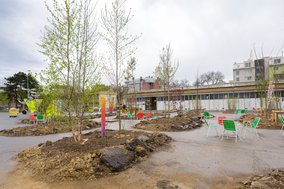Klima Biennale Wien
The Idea
With the vision and innovative power of art, the Klima Biennale Wien spurs the paradigm shift toward a livable and sustainable future on our planet. The key tools to achieve this objective are, without doubt, participation, collaboration, and awareness. The Biennale will stake out viable responses to the climate crisis together with the people of Vienna.
The Klima Biennale Wien faces the challenge of making the highly complex and acute issues of global change, the climate crisis, species extinction, and the impacts on the human-nature fabric visible and tangible for everyone: because we urgently need to find new ways of sharing knowledge and discussing strategies together!
How does the Klima Biennale Wien operate?
The profound and sweeping changes in the Earth’s system necessitate a duly holistic debate. Therefore, the concept and working method of the Biennale focus on multiperspectivity: we see the future as a shared design task and claim a space for reconciling different and sometimes contradictory positions. Precisely such frictions are fertile ground for transformations in society.
In its exhibitions, in public spaces or as part of the festival programme, the Klima Biennale Wien brings together current positions from the fields of international contemporary art, design, architecture and science that point the way to socially and ecologically just world relations. Based on the principles of care and sustainability, the Biennale proposes concrete alternatives by questioning turbo-capitalist concepts and overcoming patriarchal and colonial paradigms in favour of collective, inclusive and common-good strategies.
Theoretical and Conceptual Departure Points
In a world where economic growth is often regarded as the ultimate goal, the climate crisis is currently challenging this paradigm: How can a livable, climate-fit future be achieved? How do we negotiate the related needs? How can abstract global relationships become easier to understand?
The crisis-ridden present points to a post- growth era. Only systemic, holistic approaches will succeed in proposing a counter-model for a society where ecological balance is reconciled with economic development and prosperity.

